on peaches, and things that are nice to eat when days are warm and the sea close …
Watch the sun set in Paris, see it rise in Sète, from your seat, through the window. You’ll land into the setting up of the sea-side town’s Wednesday morning market. To piles of melons, next to piles of tangled beans, plump tomatoes, tiny potatoes and slow-ripening apricots and peaches, the season’s first figs. Crates of eschalots and garlic are off to the side, despite their irreplaceable value in the kitchen, their understated beauty won’t quite earn them a spot of glory. And you’ll stand there, looking at this scene, and you’ll think well yes, these things that have grown together, should go together, for my lunches and my dinners. A few steps on, maybe probably there will be a smiling man selling fresh goat’s cheese, a small round will bring a softness to a salad of melons, cut into crescent moon shapes, with green beans, blanched but still crunchy. A small box of Collioure anchovies will tide you over until you get to the town from where they came, and a few slices of prosciutto feels like a good, and necessary, thing. As does a mini bottle of olive oil.
Two things, two thoughts: always land in a new place the day of or day before the weekly market, always; and, the market and its growers will tell you exactly what’s for lunch, what’s for dinner, through its piles of glory, so don’t think too much about that.
A bowl for peaches, a bowl for apricots, a jar for basil and one for parsley, the fish straight to the fridge to join the melon half that has journeyed on the train from Sète to Port Vendres. The tomatoes and eggplant can go in the same bowl because they’ll probably end up being friends, sliced and tossed together with some kind of zesty salsa verde. A bowl for the haricot vert, both flat and round; the two shapes look nice tangled together. Yoghurt in the fridge, chèvre in the fridge, eggs in another bowl, next to one of potatoes, the smallest ones carefully picked out of the growers bounty. It’s rare to see potatoes so small in Australia, and these little ones were a culinary highlight on a trip to France a few years back. So it’s not really their taste that brings me to ask for a generous handful of them, but the sense of place that comes with them. Everything in its place, in that little yellow kitchen that I can see from the foot of my bed. I once was terrified of mundane, but I now realise, there’s outrageous beauty in seemingly trivial moments, like putting produce in it’s rightful place, in your rightful place, which at this moment, is Port Vendres, not so far from the Spanish border on the Mediterranean coast.
Come and go from the sea, laugh out loud as you read Judith Jones’ The Tenth Muse from a rock perfectly placed to allow you to dangle one leg into the cooling salt water; move in and out of the kitchen, take from a bowl here and a bowl there, pluck from a jar of basil, drizzle (drench) with olive oil. Slice the peach, slice the tomato, lay them together on a plate in a way that feels good. Tear an apricot open and place her on top. Then a few basil leaves and a little sardine body. Olive oil, salt, vinegar.
Breakfast one day is black coffee poured over cubes of ice and a piece of seigle (rye) walnut bread, lightly toasted, drizzled with olive oil and topped with a thick slab of fresh goat’s cheese, then an almost-too-ripe apricot smooshed on top. A bite that pleases as much as it confuses — but why is this the first time I’ve eaten this? Perhaps because it’s the first time I’m in a place where these four ingredients really sing. Yes, likely that’s it.
Home from the sea one afternoon, sun drunk, I put salt in a saucepan of water, the words of a few chefs I’ve worked with, “as salty as the sea,” feeling particularly pertinent as the salt of the sea dries on my skin. Boil the potatoes, blanch the beans, boil an egg — add a minute to the usual six minutes because I’m enjoying them harder these days. While the boiling and blanching go down, finely dice an eschalot and submerge the little squares in red wine vinegar. A teaspoon of honey and a good pinch of salt and a good stir. Let her sit while you slice a tomato, while you tear basil leaves. Whisking in a solid pour of olive oil into the now softly-pickled diced eshcalot finishes a simplified version of Danielle’s vinaigrette that I once made daily at Fred’s in Sydney for a dish I have strong feelings for: the green salad. The potatoes, sliced, and the beans and the tomatoes go into a bowl then get doused in the dressing. Pour these out onto a plate and top them with a little sardine body from the opened tin and that boiled egg, halved. More of the dressing, another salt sprinkle and some basil leaves. And it’s a joy of a time, to sit there, eating, sometimes with a fork, sometimes picking up a little potato between two fingers and pushing it against the bowl into pieces of pickled eschalot. Put the leftover potatoes in the bowl of the leftover dressing and head back to the sea, leaving the potatoes to soak up the vinegary goodness for a snack on return.
Passed the Klein blue and burnt orange house, up the stairs and onto a dirt path. On the left will be a stone house sitting next to rows of bright green vines, on the right a group of golden men, shirts off, pottering about a building site under the sun. Down a path lined with dancing silvery olive trees, your feet might slip about in your blue and white striped espadrilles, but go slowly and you’ll be fine. Look up from your dusty esps and right there will be a little cove, hugged with silvery cliffs bordering the blue as blue ocean. Climb the rocks towards a cave-like nook. Strip down and dive, and dive and dive. And then lay there, on the rocks, under the hot sun. You’ll get a whiff of something sweet and fragrant, almost coconut-like, and you’ll think back to last night, to sipping wine with Harry. Roll your head to the right and open your eyes to fig leaves, inches from your face, to a little fig tree growing in a crevice of the cliffs, bringing beauty and softness to the harsh and hard.
Pluck some of the leaves on your way home to wrap the fish you bought at the market this morning: Gut the fish, salt the fish, stuff it with slices of lemon and stems of parsley and oil it up. Wrap the tender leaves around its silvery bod and use the needle and thread your grandmother gave you for your embroidery to sew the leaves together and pop the little thing in the oven — she’s small so she won’t take long, maybe fifteen minutes in a hot-ish oven. The leaves with their emollient properties help to keep the moisture in, to tenderise, and to bring a subtle fragrant flavour. It’s quite romantic really. A quick salsa verde with the basil and parsley on the bench to spoon over the white flesh of the fish. On a plate with some boiled potatoes and green leaves dressed with the leftover vinaigrette from lunch.
It feels good.
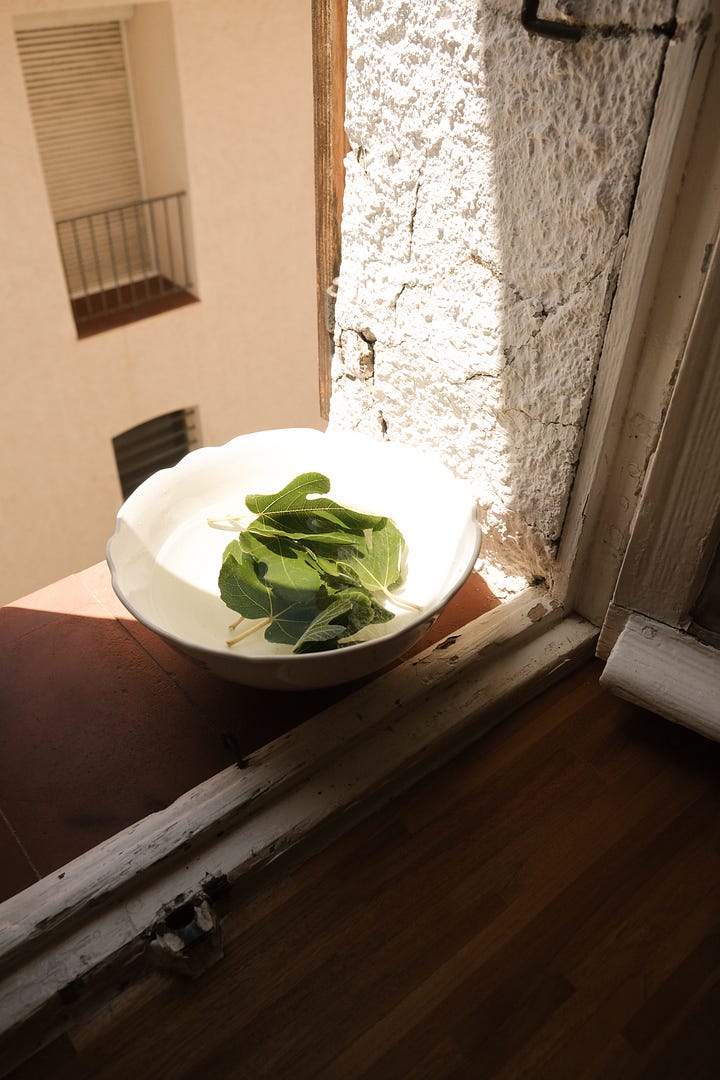
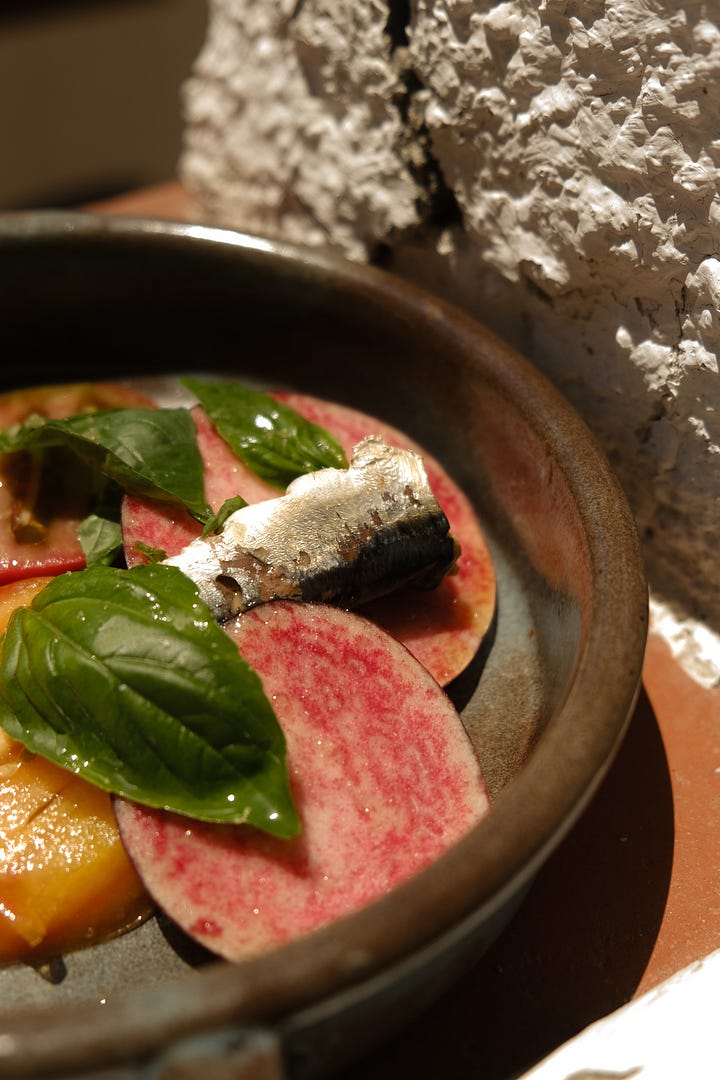
A Colette sentence that inspired:
“… the almost invisible table from which rose a pervasive aroma of slow‐ripening peaches, of red cantaloupe melon cut in slices in the shape of crescent moons, and of black coffee poured over crushed ice.” — Collette, Ripening Seed
on an unexpected lover …
He asked my name after twenty minutes of talking out the front of Cave Au Vin Vivant, a perfectly-low key wine bar in Sète, me still holding my book open like I was going to go back to it at any moment once the conversation died down. He smiled when I responded, and eventually said, “My name is Harry.” The conversation never died down. Not that night, not the next night from a bench lining the front wall of Pimpant wine bar where we drank white Corsican wine, then chilled red Corsican wine. Not the next morning when we took the advice of Patrick, the resident chef of Pimpant, who suggested oysters and coffee at Les Halles for breakfast. He said to ask the ladies at the undercover market if they’d shuck some oysters for us, to take the plate around the corner to the café-bistro — they don’t mind, he told us. And mind they did not. We sat, we sipped, espresso turned to Vermentino, and oysters to prawns.
If his chef-short fingernails didn’t give away his passion, Harry’s way of speaking about food certainly did. It captured me immediately. “As I was walking here, I had some thoughts. I thought oh god, I’ve just eaten a few raw garlic cloves over lunch, I’m going to meet Harriet and I’ve just eaten raw garlic cloves. But then I thought, actually, Harriet seems to be the kind of person who might like the aroma of garlic, and then I got a whiff of a fig tree in the warm breeze, and my worry vanished. How are you?” The first thing to come out of his mouth the day I after we meet. Garlic didn’t cross my mind as we kissed under the 2am, maybe-full moon that night.
Here are some more of Harry’s words, on tomatoes, for a lunch with 12 friends in Sète:
A favourite texture in the world would be that of blanched and peeled tomatoes. It’s just enough intervention that it enhances the texture of the tomato. As well as unveiling its natural skin which therefore allows it to suck in all that grassy sweet olive oil.
Always olive oil first.
And then crunchy fleur de sel on top.
That way the salt doesn’t dissolve in its water soluble surface and instead floats in the pool of oil.
Pop them on a bed of ricotta, a glug of olive oil, some basil leaves, probably some more fleur de sel.
And with bread for mopping. Mega.
on anchovies …
One of food’s greatest qualities is its ability to connect you to those you cherish — to have someone appear in your mind, like magic, at the sight, smell or mention of certain foods. Anchovies is a big one for me.
They connect me to Matty Hirsch, a man who I’d quite like to marry — he’s not totally opposed to the idea. A very fond memory of our Gourmet Traveller days involve Matty ordering into the office just about every tin of preserved fish he could get his hands on. It was for a column he wrote called ‘Five of a Kind’, the five of the best of that month’s chosen product. The team stood around the table in the art department, coming and going from their computers they were editing, writing, designing, researching from. Everyone took turns cracking open the tin lids of sardines and cockles and mussels, and yes, anchovies. We scooped the preserves into our mouths, probably getting olive oil all over the table. Matty took detailed notes on each and every tin. I wish I had my GT archive handy to include the piece — I’ll get it to you later down the track.
But Matty and anchovies. Matty has a tattoo, one that I think about quite often. It’s of the Ortiz Anchovies logo. I asked Matty about it again the other day, and his words could not be more relevant:
“It’s sort of a nod to how tastes change, a reminder to stay open, that your palate or your opinion always has space for evolution, and there’s real pleasure in knowing that new discoveries you find real joy in might be just around the corner.”
A beautiful truth.
They connect me to chef and cookbook author, Danielle Alvarez and author and food writer, Libby Travers, both of whom, all thanks to food, have become dear friends …
Danielle and Libby have written a book together — Recipes for a Lifetime of Beautiful Cooking — the coming together of two extraordinary women who have an outrageous amount of heart for what they do. And yes, there is the endless skill, the endless knowledge, the endless talent; the subtle and perfect way with food and words, and a combined deep understanding of cooking and food literature. But it has been the heart and the love for what they spend their days doing — cooking and writing — that has been such a joy to be around, to be part of.
I would love to share more on this special time of working on their book, where e-mails would cross seas and timezones every couple of days, from Libby and I both in France’s south, in Provence — Libby inland near Aix, me seaside in Marseille — to Danielle in Sydney. E-mails full of queries, big and small: Danielle’s preferred order of parsley, olive oil, cracked black pepper and Parmesan when finishing a pasta dish; exactly just how salty pasta water should be; Libby’s rundown of her research of the Niçoise pan bagnat, involving a video of a friend’s mother recounting in great detail the process of making the beloved sandwich — one steeped in history and tradition — after having spent many a years making and eating the delicious thing in the part of the world from which they come. But for now, anchovies.
It was through editing this book that I came to learn of the seaside town of Collioure, the centre of anchovy production during medieval days. It all dates back to the 1400s — anchovies a mere 600 years ago, when the salting of the fish gained such commercial importance that King Louis XI of France exempted the town from the salt tax. All quite far from where my palate relates anchovies to — places usually involving Sydney and a bar stool, like Don Peppino’s circa 2019 via something like a finger of pane fritto, smeared with tomato sago and topped with a single Ortiz anchovy. I can just feel this dish in my mouth. Sitting on a bar stool in Sydney, you mightn’t think about the little salty fish on your plate having been the driving force of the economy in a seaside town on the other side of the world. Quite astonishing really. Collioure was home to over 20 salting houses well into the 19th century, and to fleets of the small, wooden fishing boats, catalans, that lured the likes of Matisse to the port to capture in paintings.
This staple of Catalan cooking has been over-fished in the Mediterranean so they now come from further afield — off the coast of Brittany, or Argentina — I’m told on a visit to Roque, one of the last salting houses in the town. The rising water temperatures have also driven the little beauties away from the Med. However, they are still treated in much the same way as they have been since this family opened in 1870 — all by hand. It’s said that what truly makes a Catalan anchovy is the way in which it’s prepared. During the season from May to October, the little fish arrive, they’re set in salt for around two to three weeks to extract their juices and blood. They are then gutted and beheaded and arranged inside barrels between layers of salt and weighted down to keep them compressed, allowing the salt to penetrate the fish and in turn, preserve them. After about three months, the little fish are carefully deboned — quite the craft — traditionally with the small and dexterous hands of women, and are prepared in the three ways this salting house sells them: in sunflower oil (milder than olive oil to allow for the anchovy flavour to shine), in a pickle or in salt. They’re plump, they’re perfectly salty; yes, they are quite simply sublime.
“Anchovies are like fruit, if they’re not ripe, they don’t have as much flavour. And for an anchovy to be ripe, it should have a rich aroma and a rosy colour.” — Guy Roque
Danielle and Libby share a love for many things, the little salty fish being one of them. The book’s recipes for pissaladière and bagna cauda and pan bagnat swirl about my mind often, as do Libby’s words of a “a warm bath of anchovy” — words you want to hear in the same sentence, especially when it’s about a dish that is suggested for an intimate night with your lover. Probably best to pop off now and pre-order the book, for a hefty list of reasons, one of them being: anchovies.
They make me think of Georgia Lahiff, a woman and a chef who I’ve had huge admiration for from the moment I heard of her. Her way with food, and life, is pure joy, pure pleasure. We’ve become wonderful friends — life is nice like that.
Back in my Port Vendres kitchen, a little sun kissed after a long morning of swimming, a lot tired and a lot hungry, Georgia’s voice swirls around my mind as I look at the eggs and the jar of Roque anchovies sitting on my bench.
I’d recently interviewed G for a piece, and her answer to the below question really struck a chord, and as I write this, I realise it most definitely played into my heading south, into my desire to be in the place of anchovies.
“It’s your day off, you’re at home and it’s lunch time. What are you making yourself?”
I pound, I drizzle, I shave, I whip and I scoop the resulting velvety dressing over slices of warm tomato, a halved boiled egg, some blanched green beans, a few little boiled potatoes; to the plate go a few sardine fillets, a couple of crunchy cold radishes and a little bowl of black olives. A bit of a Niçoise vibe, if you will. G’s right, a happy place.
You can read the interview with Georgia for IN BED here, where G will make your lips smile and your mouth water, if not with anchovy or caponata chat, with her recipe for braised artichokes. The piece is a feast for the eyes, too, with talented Milan-based photographer Stefania Zanetti capturing Georgia doing her thing during her last week at Rome wine bar, Enoteca L’antidoto.
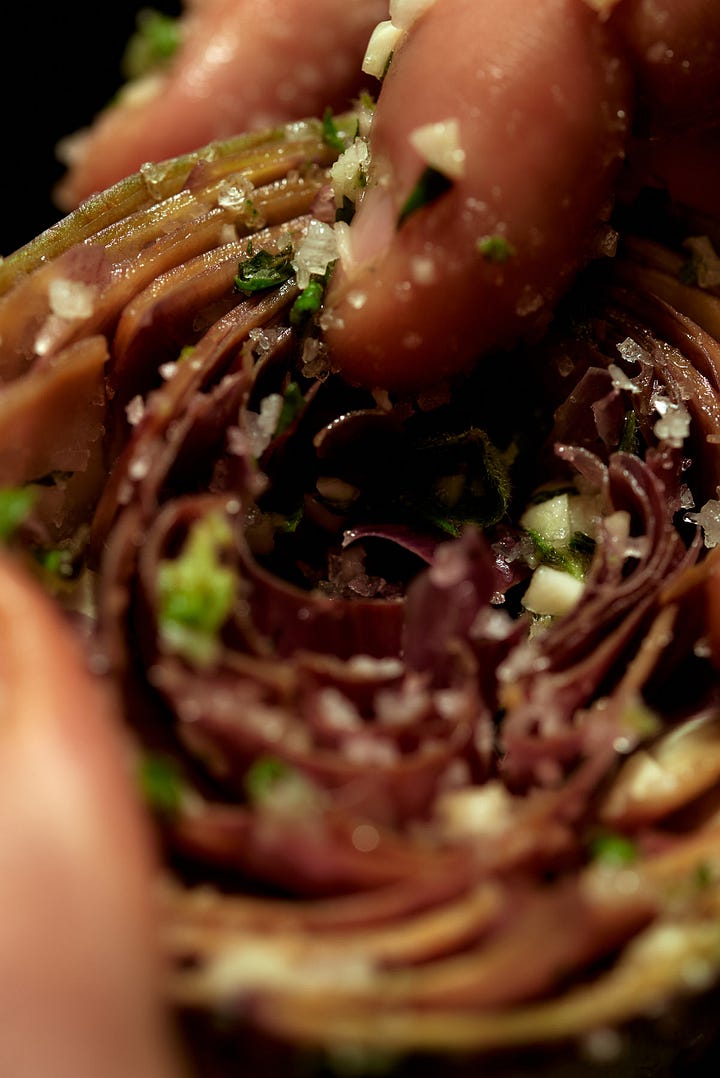
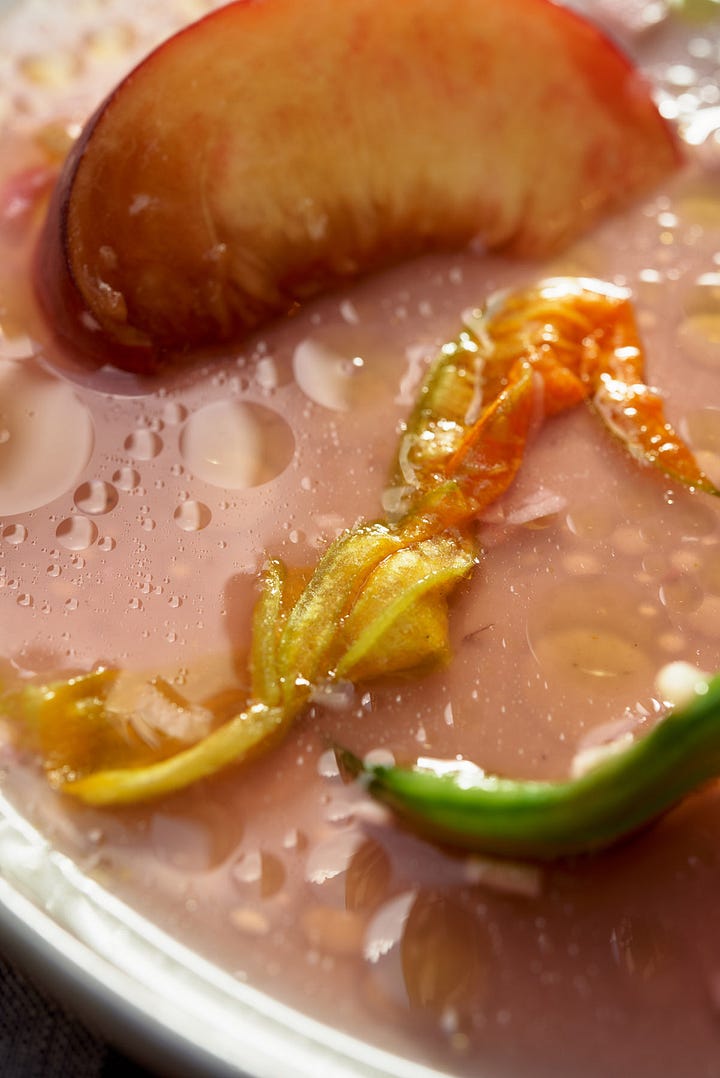
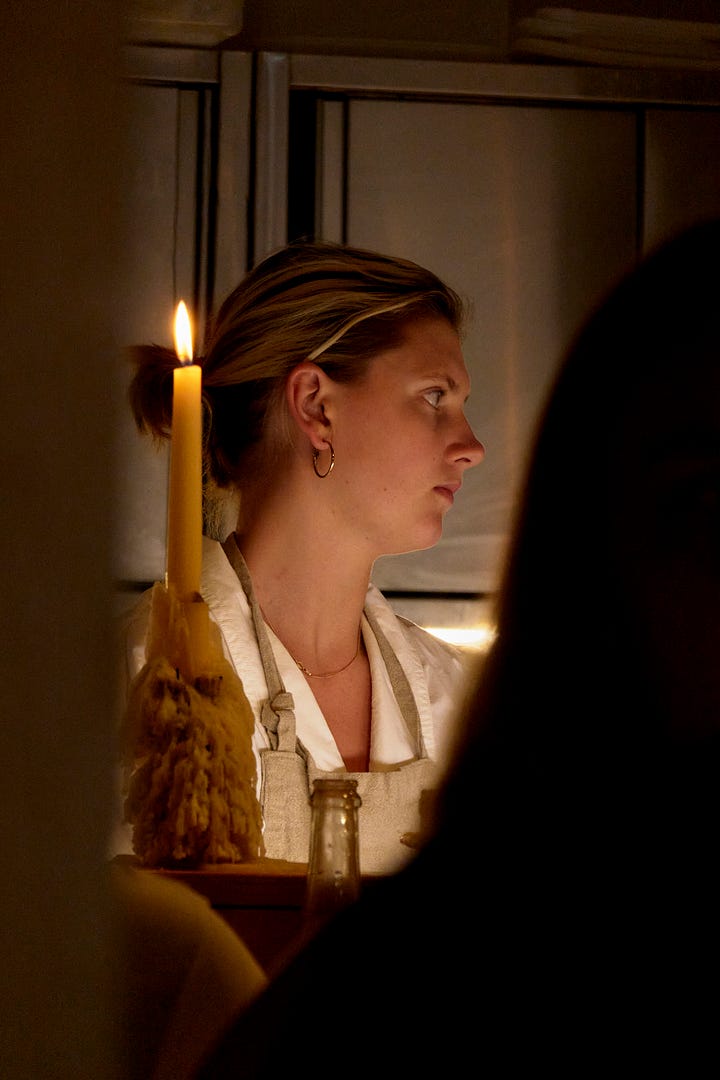
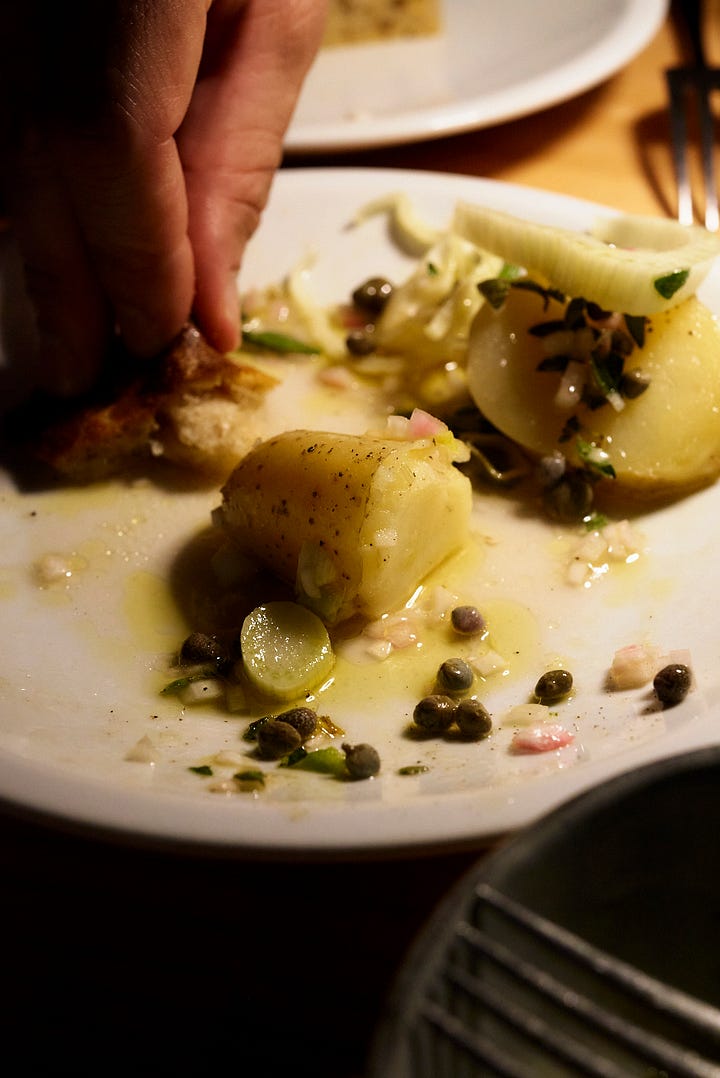
on the sun and the sea …
Saturday in Port Vendres — the annual Fête de la Pêche, festival of the fisherman. I make it down just in time for a plate of Catalan paella — mussels, prawns, chicken drum sticks, longaniza sausage, a fish I couldn’t identify, saffron, peas — on the old port with the Scottish-Parisian neighbours, and a French woman who lives downstairs with 13 cats. Conversations about dwindling fish as a result of large fishing boats, or because of the pieds noir bringing with them intensive fishing practices when they returned to France after Algeria was granted independence in the early 1960s. A band with a saxophone, kids jumping off the pier into the sea over and over again, a cold glass of Banyuls — a chilled, sweetish fortified apéritif from the area. This is the life.
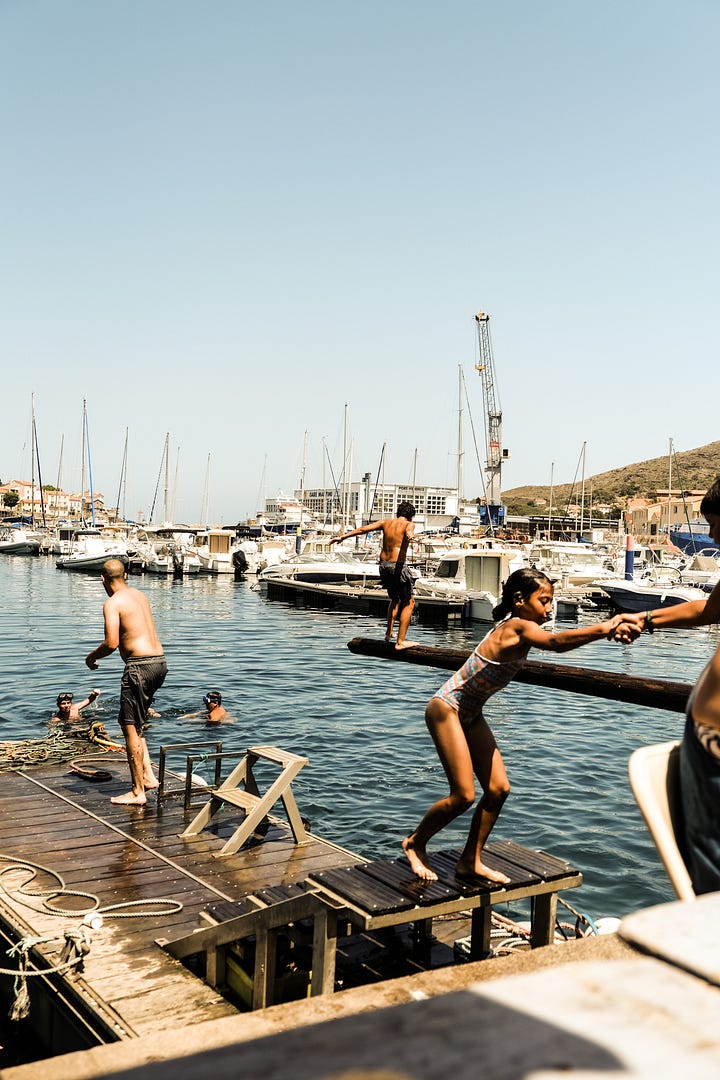
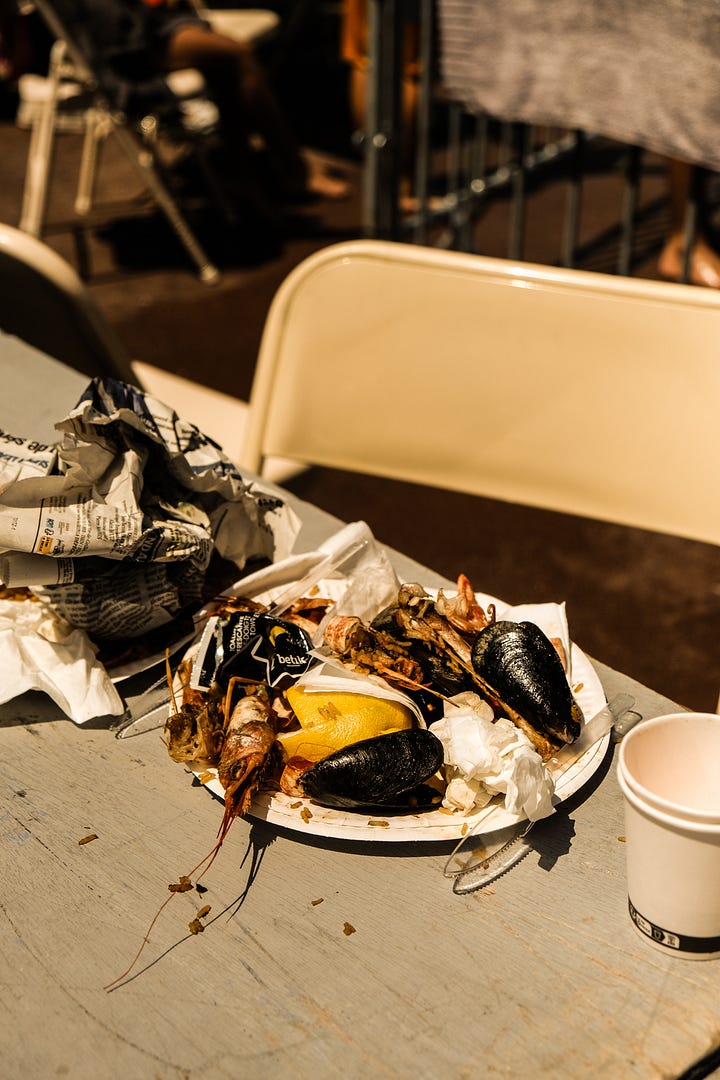
A walk over the hills, from Port Vendres towards Banyuls. Walk around the port, passed the restaurant Le Poisson Rouge perched half on the beach, half in the sea, dream of coming back for lunch one day, and wander up onto the rugged hill. Follow long, winding paths on the edges of the cliffs, the only thing between you and the horizon of the Mediterranean are white sailboats. Spot a plant that looks mighty like lentisk, a shrub that you’d read about just that morning in Patience Gray’s words on landing in Catalonia, on writing her book Honey From a Weed , “… I am held in the mysterious grip of olive, lentisk, fig, and vine".
From the high cliffs, stop to look down at the bodies diving off the yachts anchored in the middle of the deep blue sea. Stop to look up at a stone house, let your imagination run wild, thinking about Patience walking out the front door, into the vegetable garden sitting just outside the kitchen, overflowing with vegetables kissed by the salt of the sea from the ocean that it looks out onto. Stop for a swim, eat your peach, watch two couples, probably in their seventies, splash about, not one of them wearing a top.
You'll swim four times before you stop to perch on a stool at a bar on the beach, and order a bière blanche that’ll come out with a little bowl of green Lucques olives. You’ll watch the golden bodies swim under the last light of the day, then go and dive in yourself before you walk home along the road lined with vineyards, feeling the beer after having eaten no more than a peach for lunch. Fried anchovies with aïoli on the old port just minutes from home are one of your best moves yet, served with a cold glass of Banyuls.
Claudia, the chef, golden from days off by the sea, tells me: behead the fresh anchovy, roll it in flour that has a bit of salt through it and lower it into a heated neutral frying oil that is hot enough so that when you add the little fish, it bubbles. Once she’s golden, take her out, put her on paper towel to drain, finish frying the remaining fish in batches and serve with aïoli and lemon wedges.
Arrive at Banyuls, a town where anti-Nazi activists, Lisa and Hans Fittko, settled in 1940 and, working with the mayor on the sly, helped to save a great number of mostly Jewish intellectuals, artists, writers, political refugees to freedom across the Spanish border (watch the story in Transatlantic). You’re just in time for lunch at Al Reparo, a restaurant that a new and wonderful friend sent you to, along with the description: family run, true Catalan food, cheap. Sit down at the window-side table. The son will talk you through the menu, you’ll be tempted by the salade melon, menthe but order the escalivada maison followed by the civet de calamari, and almost in the same breath say, “would you mind terribly if I run across to the sea for a dip before lunch and come right back?” He’ll smile. You run across the road, barefoot, peeling off your dress as soon you hit the heated sand, and dive in. And you’ll smile. You’re back in your seat, at your red-checked table, in no more than five minutes, and your plate of roasted aubergine, peppers, courgette and tomatoes drenched in olive oil arrives. God the food is good. I see a woman wander out of the kitchen, through the restaurant, out the front door, across the street and reach for the helmet on the back of a scooter. I ask the son if it’s his mother, who’s also the chef. “Yes.” I run across the road towards her and thank her for a meal, a lunch, I’ll remember always, that will inspire my cooking, always.
Her smile is huge, her face warm.

Since being back up north, close by to Paris, I’ve had two people say to me, “You came back — I thought I’d never see you again.”
I can’t say it enough, I’m so glad you’re here.
H.





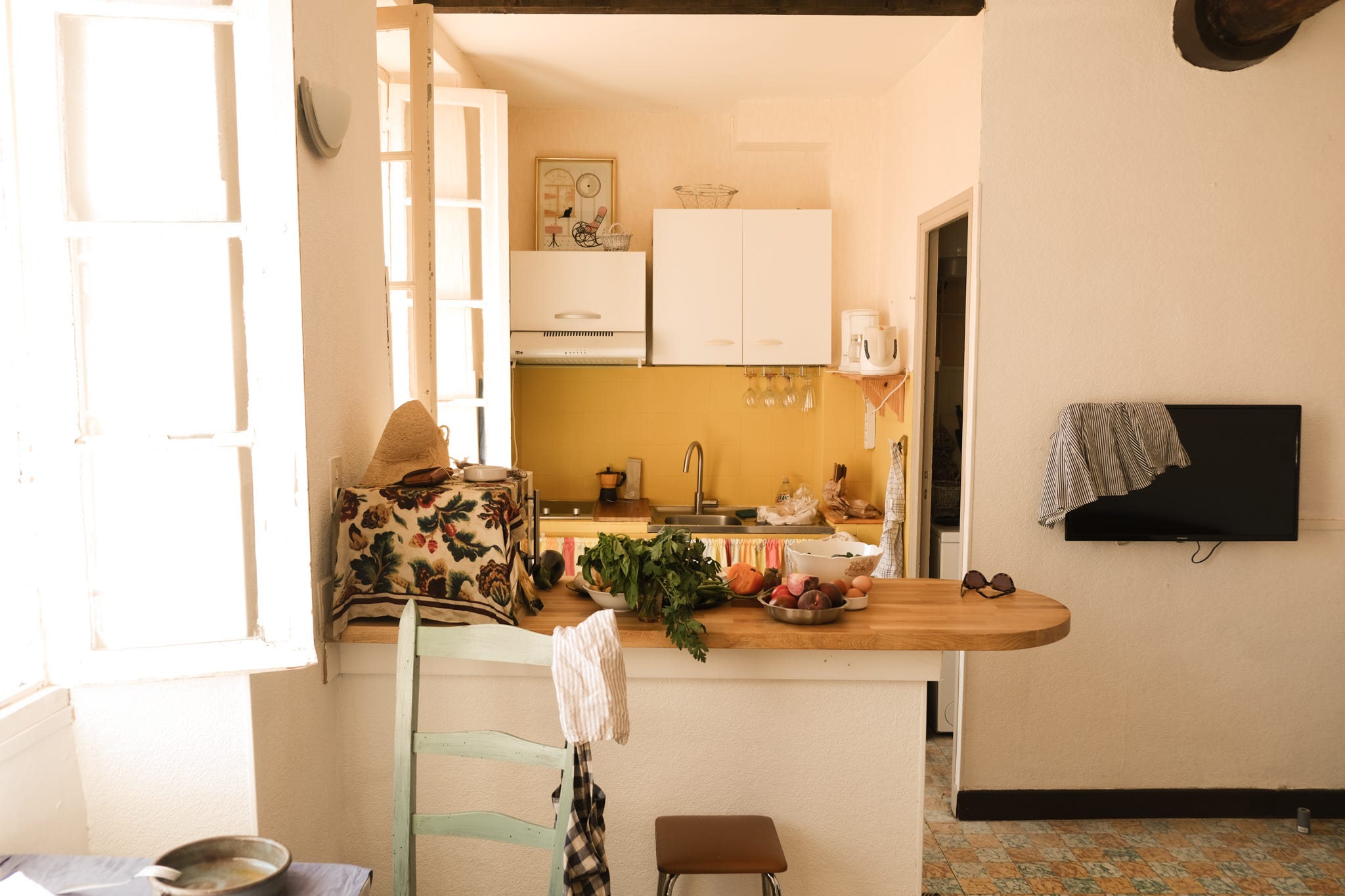



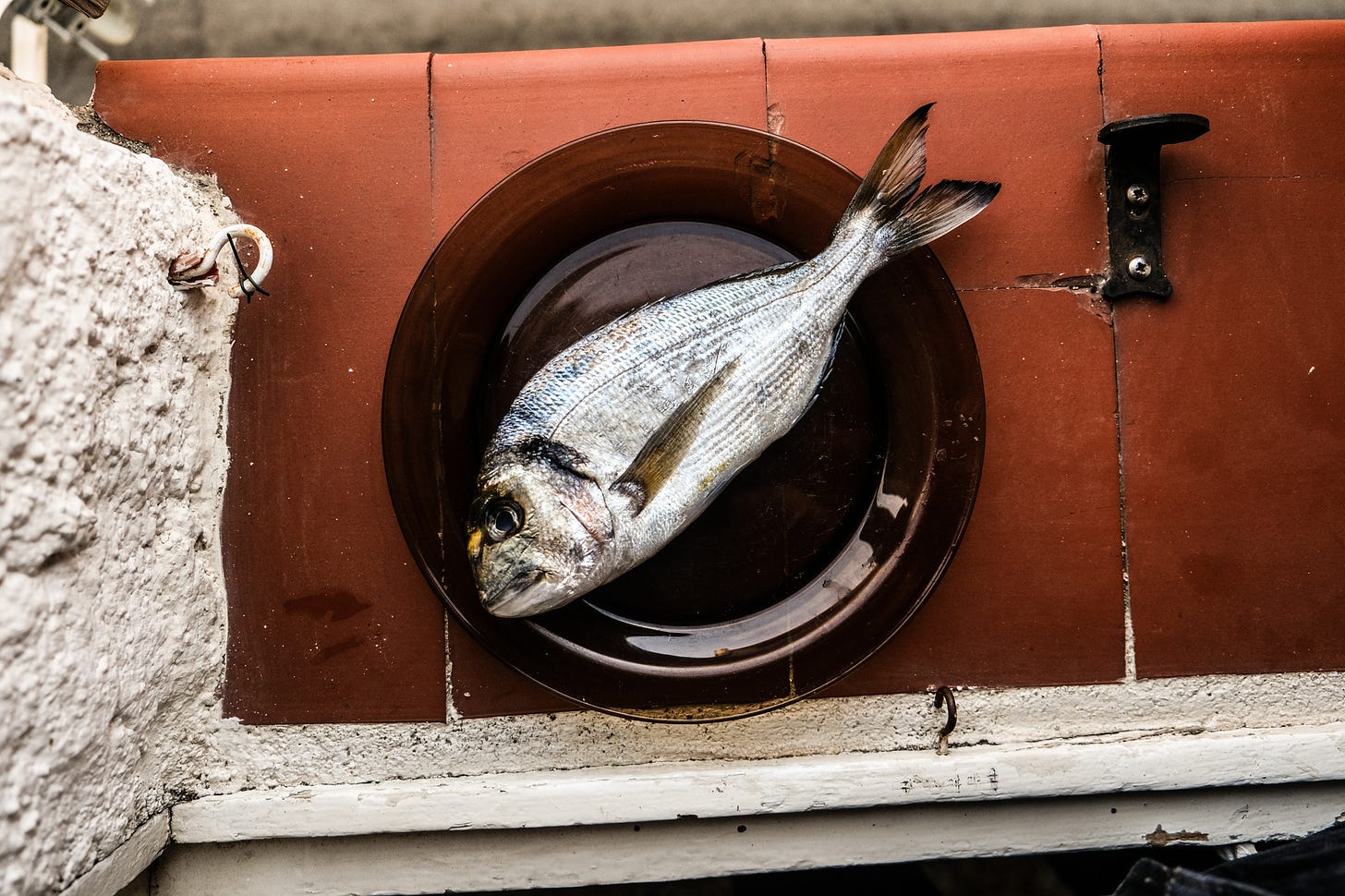
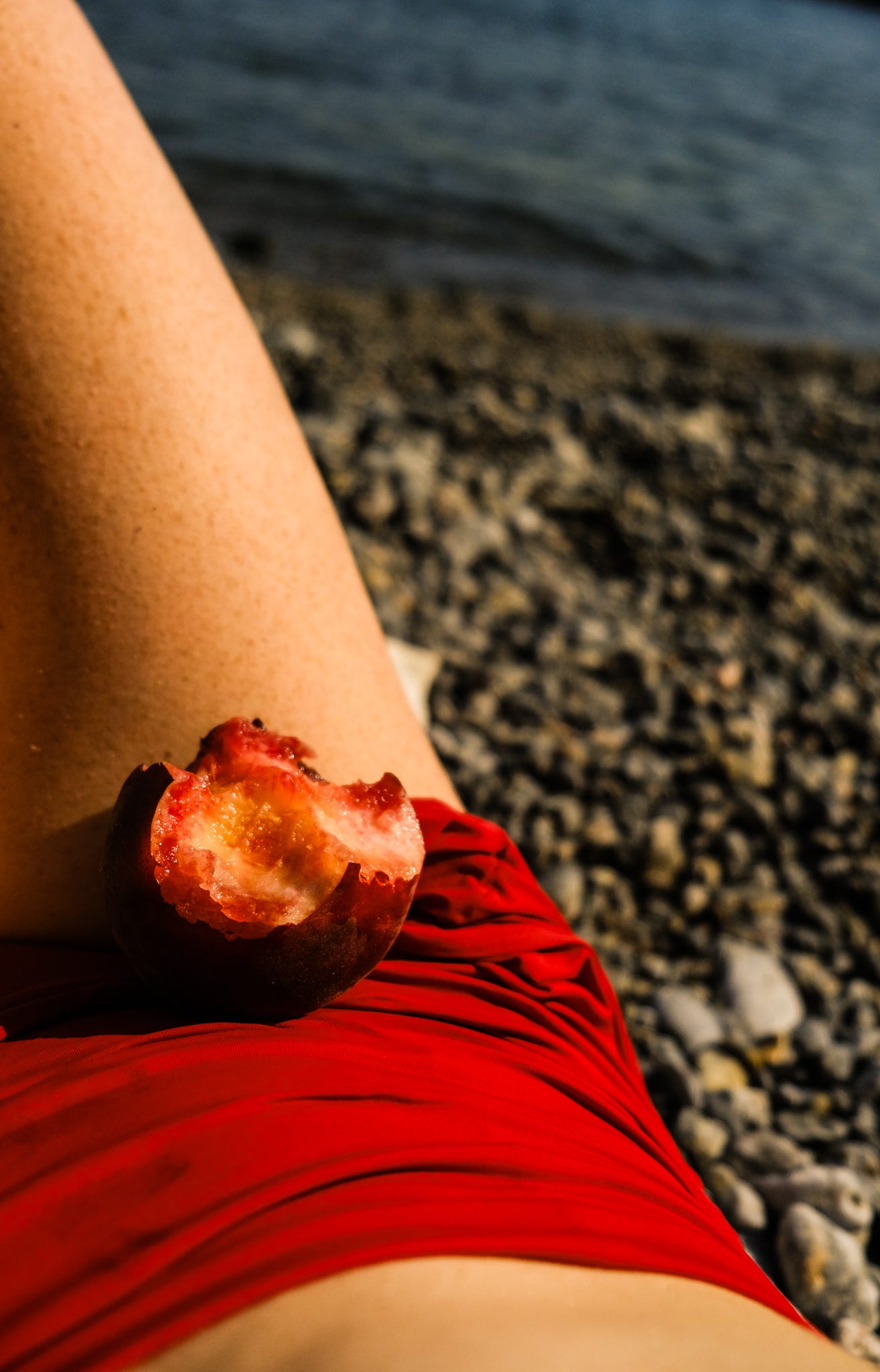

Imbued with light, flavour you can nearly taste, mouth watering, fish, salt, fruit, sun, the romance of food, the romance of living in the moment, the romance of romance... heaven!
The zest, the pith, the juice AND the flesh of life, all muddled clearly and beautifully. A true joy! Xx
Au Top!